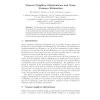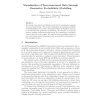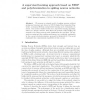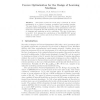ESANN
2007
15 years 2 months ago
2007
In this paper, we address the problem of deriving bounds for the moments of nearest neighbor distributions. The bounds are formulated for the general case and specifically applied...
95
Voted
ESANN
2007
15 years 2 months ago
2007
We present a generative probabilistic model for the topographic mapping of tree structured data. The model is formulated as constrained mixture of hidden Markov tree models. A nat...
107
click to vote
ESANN
2007
15 years 2 months ago
2007
We propose a network model of spiking neurons, without preimposed topology and driven by STDP (Spike-Time-Dependent Plasticity), a temporal Hebbian unsupervised learning mode, biol...
ESANN
2007
15 years 2 months ago
2007
In this work we show that entropy (H) and mutual information (MI) can be used as methods for extracting spatially localized features for classification purposes. In order to incre...
82
Voted
ESANN
2007
15 years 2 months ago
2007
To examine the feasibility of estimating the degree of “strength of belief (SOB)” of viewer’s responses using support vector machines (SVM) trained with features of gazes, t...
107
Voted
ESANN
2007
15 years 2 months ago
2007
Local algorithms for non-linear dimensionality reduction [1], [2], [3], [4], [5] and semi-supervised learning algorithms [6], [7] use spectral decomposition based on a nearest neig...
84
Voted
ESANN
2007
15 years 2 months ago
2007
Abstract. In order to explore the social organization of a medieval peasant community before the Hundred Years’ War, we propose the use of an adaptation of the well-known Kohonen...
99
Voted
ESANN
2007
15 years 2 months ago
2007
Abstract. As potential candidates for human cognition, connectionist models of sentence processing must learn to behave systematically by generalizing from a small traning set. It ...
88
Voted
ESANN
2007
15 years 2 months ago
2007
This paper proposes a novel nonlinear transient computation device described as the LTCM that uses the chaotic attractor provided by the Lorenz system of equations to perform patte...
79
Voted
ESANN
2007
15 years 2 months ago
2007
This paper reviews the recent surge of interest in convex optimization in a context of pattern recognition and machine learning. The main thesis of this paper is that the design of...




